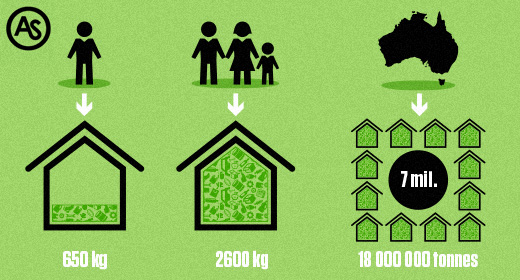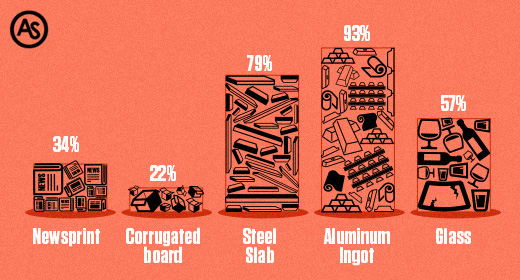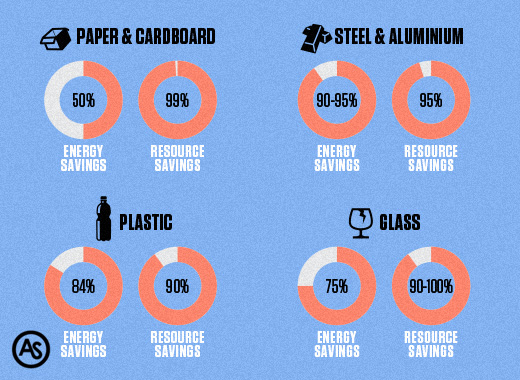Where Are We On Recycling And Is It Enough?

Behind USA, Australia is the largest waste producer, per person, in the world. The average Australian citizen produces over 650 kg of waste per year, making a family of 4 produce enough waste to fill a three – bedroom house, from the floor to the ceiling! Annually, we contribute to over 18 million tonnes of waste, half of it coming from households.
Every day, 1% of households and businesses in Australia change their waste management tactics and focus their efforts into recycling, making Australia one of the global leaders when it comes to recycling contribution. Raising awareness plays a major role to the contributing factors and it will continue to do so until we begin minimising our waste output and maximising recycling and re-production, respectively.

Two recent studies have shown us just how deep of an impact recycling plays on the environment and on general energy consumption.
- Life Cycle Assessment for Paper and Packaging Waste Management In Victoria – Melbourne’s research project, lead by a group of universities to investigate the environmental benefits of recycling waste against landfill waste.
- Nationwide research, commissioned by the National Packaging Covenant Council (NPCC), called Independent Assessment of Kerbside Recycling in Australia. As the most comprehensive study of recycling ever conducted in Australia, this research report measured the financial, social and environmental impact of recycling by comparing costs and benefits.
Two different methods were used to analyze and compare the impacts of recycling and that of dumping waste into a landfill. Both studies have proven that recycling plays a major role in the preservation of the environment, while cutting down energy, thus lowering the cost of future production.
Lowering Greenhouse Gases
Nearly half of the greenhouse savings created by recycling were found to be from lowering the creation of methane gas: Methane gas is generated at landfills as paper waste breaks down (Around 55% of that methane gas would be held just for generating power). The rest of the greenhouse gas de-escalation occurred by getting rid of of virgin material production (If a product was made from raw material rather than recycled material, more carbon dioxide, with other greenhouse gases would have been generated).
Energy
Savings
Recycled products presented lower levels in embodied energy: energy consumed during every step of the production, from the product retrieval of the raw materials, to the processing and finally the disposal or recycling.
Product Embodied Energy Savings:

As the initiative to recycle grows globally, Australians have been amongst the first to lead the pack. General awareness is on a high level and the will to contribute rises with it.
A study, by the Australian Bureau of Statistics, was conducted in 2012, where 8,692 households were interviewed, The study concluded that out of the total number, 8,422 households took a part in recycling, 6,328 stated that they reused products, while only 183 households admitted that they never recycle and never reuse.
The same study provided us with the most common objects recycled in Australia. Leading the way, paper and cardboard are the most recycled materials nationwide.
Paper and Cardboard
- Over 5 million tonnes of paper and cardboard were used from 2007 to 2011, and only 2.5 million tonnes were recycled.
- Making paper from recycled materials used 99% less water and 50% less energy than making it from raw materials
- Paper breaks down very slowly in landfills due to the lack of oxygen, thus creating methane gas which has a greater greenhouse gas impact on the environment
Steel and Aluminium
- In 2010, only 30.3% of steel and aluminium in Australia was recycled. This means that over 50% of steel and aluminuim still goes into landfills across the nation.
- Almost every Australian has access to recycling services, yet they do not feel the need to visit them. It has been estimated that in the same year, Australians sent enough steel and aluminium to landfills to make over 40,000 fridges!
- Producing one aluminium can from raw material takes up as much energy as producing 20 of them from recycled materials
- More than 2 billion cans are recycled in Australia each year
- Energy saved from recycling one aluminium is enough to keep a TV running for over 3 hours
Plastic
- Australians use over 350,000 tonnes of plastic every year. In the year 2010, 288,000 tonnes were recycled.
- While the production of plastic required coal, oil and gas, its production emits greenhouse gasses and contaminates our oceans.
- Making plastic bottles from recycled materials uses 84% less energy than that of its production from raw materials.
- By creating products from recycled plastic, we use 90% less water, reduce carbon dioxide by 2.5 tonnes and lower energy usage by over two thirds.
Glass
- Glass is made from ash, soda, limestone and sand, which make it able to be recycled an infinite amount of times.
- Making products from recycled glass uses 75% less energy than from raw materials
- 25% of new bottles and jars are made from recycled glass
Organics
- Organic materials undergo anaerobic decomposition, which generates a potent greenhouse gas – methane.
- Food organics in landfills is the second largest source of methane
- Around two-thirds of all waste sent to Australian landfills consists of organic materials
On average, every Australian citizen, annually, throws out 330 kg of paper, 552 kg of aluminum cans and 414 kg of food. In today’s society, we are able to virtually recycle anything that we use on a daily basis. Extensive research and advances in technology will push that barrier even further over the course of years. Although we are making great strides towards progress, there is always room for improvement. One of the greatest initiatives taken by the government is the creation of the Perthwaste Green Recycling. Recycling plants such as this one safely exhaust every opportunity to recycle, cost – effectively. Building and using more of these plants will get us to our desired goal in a shorter amount of time.
Between years 2007 and 2011 Australians increased their recycling efforts from 21.4 million tonnes to 27.3 million tonnes (all recycled materials – Australians throw out 18 million tonnes of waste per year). We still have to work toward removing waste from landfills and creating new products by reusing the old. By reducing landfill waste, we will preserve our environment and prevent further climate changes, simply by the removal of greenhouse gasses. Reusing waste materials and creating environmentally friendly products will only play a contributing role in saving our planet.
Source: http://www.environment.gov.au/topics/environment-protection/nwp/reporting/national-waste-stream
Source: http://wastech.com.au/case-studies/perth-waste/
Source: http://www.pca.org.au/site/cms/documents/packaging-issuesandpuzzles.pdf
 Follow
Follow